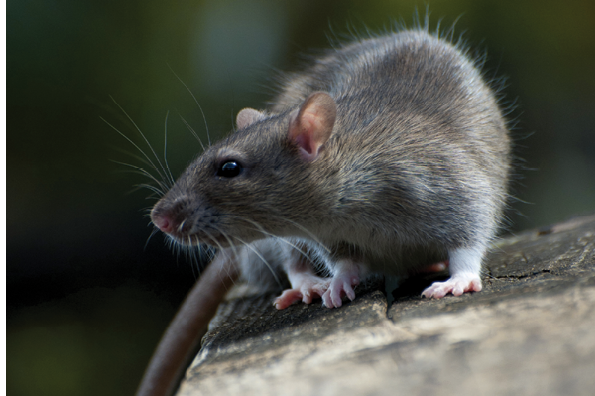
Believed to have roamed the earth with dinosaurs, rats have outlived several mass extinctions, an ice age, atomic bombs and meteors. Even their 75-million-year-old bite marks live on today in fossilized bones.
The resilient rodents come with a portfolio of physical and behavioral capabilities that make them the ultimate survivors. They can tread water for up to three days, land uninjured from a 50-foot fall, squeeze through the tiniest crevices and reproduce prolifically.
Let’s take a look at some of the impressive characteristics that have allowed this pest to stick around for so long and what pest control operators can do about rats’ growing populations.
BODY. Rats possess a unique set of bodily characteristics that enable them to access almost any space, squeeze through almost any hole and jump from almost any surface. Among the smallest of mammals, rats have flexible skeletons, so they can wiggle through openings as small in diameter as a quarter. If you’re considering flushing the furry foe down the toilet, chances are it’ll survive. Rats can swim over a mile in the open water. And if you’re waiting for a cold winter to wipe them out, think again. Rats’ furry coats keep them warm during extremely cold temperatures, and their tails allow them to regulate their body temperature by expanding and contracting their blood vessels.
DIET. As omnivores, rats can (and do) eat almost anything. Their primary provider of food? Humans. With the right access to food, shelter and water, rats will likely set up shop and start building a community. Water doesn’t rank particularly high on that list, as a rat can go longer without water than a camel. These creatures don’t typically try new foods, and when they do, they try them in small amounts. If a food makes them sick, they won’t eat it again. This is why rats are so good at avoiding rodenticides.
TEETH. In addition to allowing them to enjoy an assortment of food, a rat’s impressive set of choppers also helps them chew through much more. The creature’s front teeth grow 4½ to 5½ inches each year and are harder than iron or steel. Their strong, sharp molars enable them to chew through almost anything, including cinder blocks, wood, bricks and lead pipes, just to name a few.
BEHAVIOR. Rats possess fascinating behavioral characteristics that make them extremely hard to catch and difficult to separate from their furry friends. They’re exceptionally timid creatures and secretive by nature. Rats operate at night, can see in the dark and are always on alert. All of this is to say, it’s quite rare to surprise a rat. This is why people don’t typically realize they have rats until an entire family is living in their walls. Once rats are seen in the day or out in the open, you have a real problem.
Rats are also highly social animals. When meeting other rats for the first time, they’ll smell each other’s breath to determine where their new rat associate has been and what it has been eating. They’re also affectionate creatures. Believed to feel sympathy, empathy and depression, rats will take care of injured and sick rats in their group before taking care of themselves.
REPRODUCTION. Even if you’re able to outsmart these highly adaptable creatures and get rid of a few rats, you likely will only scratch the surface of the problem. The number one survival trait that has allowed rats to survive for millions of years is their ability to reproduce vastly and quickly. With a gestational period of approximately 21 days, rats are baby-making machines. Their pups become fertile at as young as five weeks of age. Thus, what started as a pair of rats can turn into as many as 1,000 rats in one year.
SOLUTIONS. The more we learn about rats, the easier it is to understand how they’ve outlasted almost every climate and condition. Their unique blend of physical and behavioral traits have allowed them to survive for millions of years — and likely for a million more to come.
In my opinion, rat traps alone won’t solve a rat problem; rodenticides have some limitations and, in certain situations, can present secondary poisoning concerns; and some homeowners and PMPs feel glue traps are inhumane. From my perspective, pest control operators should implement an instantaneous, humane and effective trap that can be scaled to address a widespread problem. If PMPs continue to use traditional methods of rat control, these resilient rodents will continue to repopulate as they have for millions of years. No wonder their population keeps growing despite our best efforts!
Blair Calder is president and founder of Automatic Trap. Learn more at www.automatictrap.com.

Explore the August 2018 Issue
Check out more from this issue and find your next story to read.
Latest from Pest Control Technology
- SiteOne Hosts 2024 Women in Green Industry Conference
- Veseris Celebrates Grand Reopening of the Miami ProCenter
- Rollins' 2024 Second Quarters Revenues up 8.7 Percent YOY
- Fleetio Go Fleet Maintenance App Now Available in Spanish
- German Cockroach Control Mythbusting
- Total Pest Control Acquires Target Pest Control
- NPMA Workforce Development Shares Hiring Updates
- Certus Acquires Jarrod's Pest Control





